
3 Ways to Maximize your eCommerce Business Profitability with AI
Editor’s Note: This is a guest post written by Chet Butikofer, VP of Innovation at Teikametrics.
2020 will go down as the largest inflection point the online retail industry has ever seen, and analysts everywhere are watching. In June, Morgan Stanley raised their growth estimates for U.S. eCommerce by roughly 10% for 2020 and 2021.
Morgan Stanley Increases U.S. eCommerce Growth Estimates for 2020 & 2021
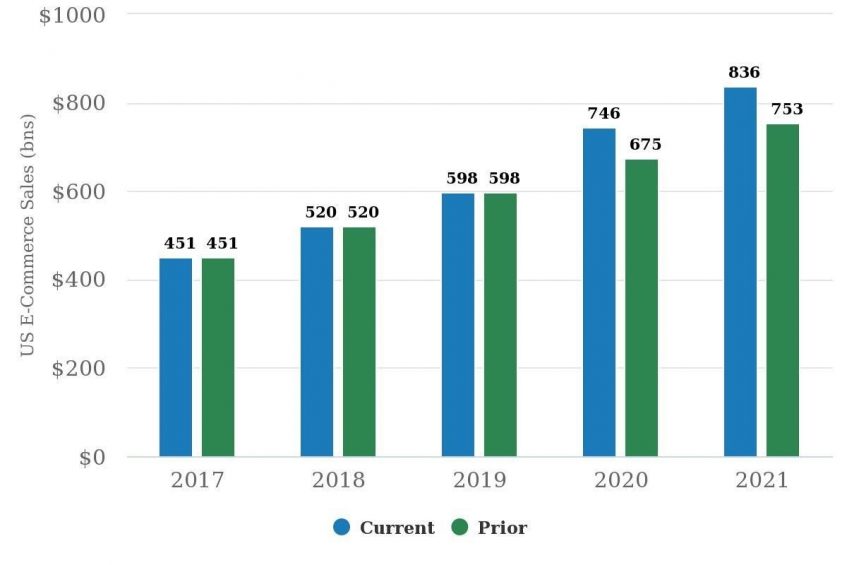

With this in mind, it’s worth asking yourself, five years from now, will you be able to look back on a season of unprecedented growth where your business accelerated and became more profitable than ever, or was it a season of time-consuming tasks and personal investment that failed to yield the profits you were hoping for?
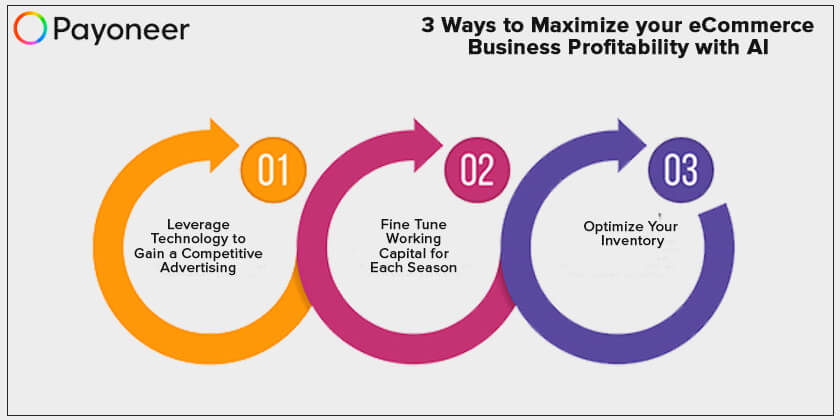

We hope it will be the former. But it won’t just happen automatically. We believe that those businesses which successfully capitalize on this unprecedented online demand will use three proven strategies to turn their ecommerce business into a more efficient, cash-generating machine.
1. Leverage Technology to Gain a Competitive Advertising Advantage
If you want your product to be discovered on today’s ecommerce marketplaces, you need the right tools to manage your advertising strategies. According to Amazon’s data, 70% of shoppers never click past the first page of marketplace search results. Amazon’s Brand Analytics data from September 2020 also reveals that across their top 100,000 search terms, 46% of all organic conversions were captured by the first three organic results.
If your brand is not on the first page, you’re not going to be discovered. Today, that first page of search results is increasingly driven by advertising – not organic listings.
The brands that are going to win will be the ones that can secure a competitive advantage with sponsored advertising on Amazon and other marketplaces.
But marketplace advertising engines are becoming increasingly complex and dynamic. For example, let’s assume you are advertising 100 products on Amazon. The average product on Amazon generates revenue from about 99 keywords and revenue per click meaningfully fluctuates 18 times per month for the average keyword. That means that in order to run an effective advertising campaign and bid optimally on CPC keywords, you would need to make 180,000 bid changes per month. And that’s not all, 90% of those bid changes will first require modeling clustered sparse keyword data to get it right.
Manually making updates in your marketplace campaign manager is obsolete, inefficient, and better done by a machine that will make the right changes at the right time without ever taking a break.
Solutions like Teikametrics Flywheel, a self-service platform that combines analytics, automation controls and artificial intelligence to drive the best return for your ad spend on Amazon, enable you to do just that by automating the entire advertising process and make managing your campaigns far more efficient and cost-effective.
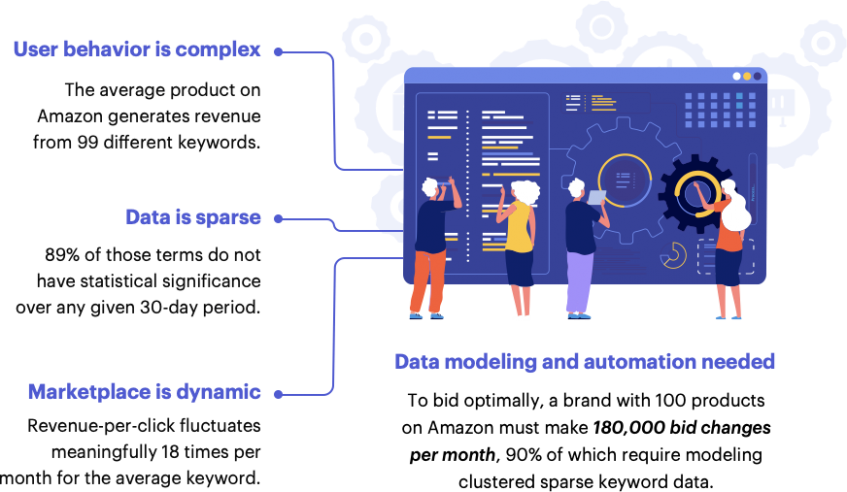

2. Optimize Your Inventory
Your ability to measure the smallest changes and make timely adjustments to your product inventory could mean the difference between solid profitability and outright failure. The best advertising won’t generate profit if you aren’t able to deliver on the demand.
Costco is an important example of how to employ strategy and metrics to optimize inventory. In fact, it’s one of the main reasons they are able to sell products at such low prices. So much so that in their most recent fiscal year ending August 2020, Costco reported an inventory turnover ratio of 12.25.
Inventory turnover ratio or inventory turns refer to the number of times a company has sold and replaced inventory over a certain period of time. This metric is critical for your business as it drives free cash flow. Dividing the number of days in a year by this ratio gives you the time it takes to sell an average unit of inventory. In this case it’s just under 30 days.
Online Marketplace Dashboards Don’t Have the Right Data
The problem facing today’s ecommerce sellers is that online marketplace dashboards don’t have access to the right data that is needed to truly optimize inventory. Let’s look at a quick example:
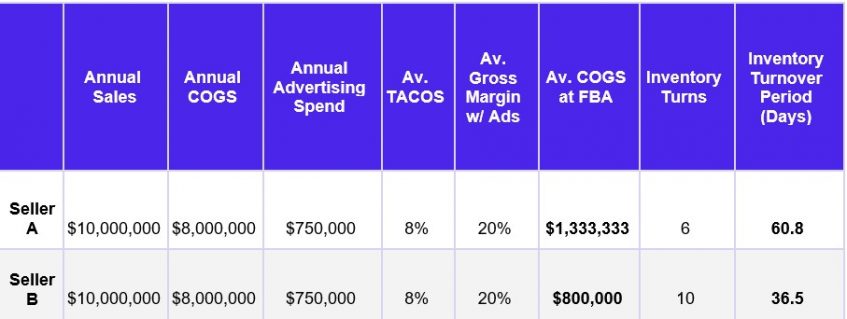

In this example, both Seller A and Seller B spend $8M to realize annual sales of $10M for their respective businesses. To find out how many times they sold and replaced their inventory during the year, divide COGS by Average COGS at FBA.
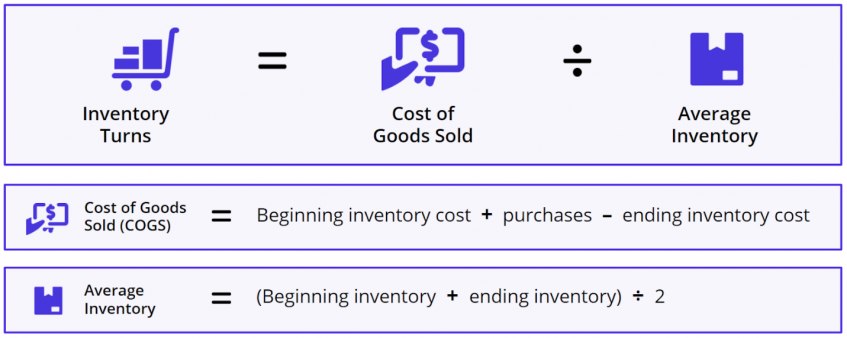

The result is an inventory turnover ratio of 6 for Seller A, while Seller B has an inventory turnover ratio of 10. This means that Seller B held each SKU in their inventory for an average of 36.5 days as opposed to 60.8 days for Seller A. That’s more than a 3-week advantage for Seller B. This advantage means that Seller B is able to achieve the same output as Seller A with 40% less cash tied up in inventory.
Online marketplace dashboards cannot automate this calculation in real time because they lack your critically important cost of goods sold (COGS) data. They also can’t provide insights to help your businesses optimize inventory and profitability across different marketplaces.
Do you know the inventory turns for each SKU you are selling? Do you understand how that number impacts profitability? Find the right tools for inventory management and you’ll be light years ahead of the competition.
3. Fine Tune Working Capital for Each Season
According to the Wall Street Journal, there are as many as 13 to 20 shopping seasons during the year, and currently, we are in the biggest and most demanding one of them all. As an eCommerce seller, you need to make sure you have the right amount of working capital for each season. Working capital is the lifeblood of every business. Without efficient cash flow, you will have no chance of optimizing advertising and inventory.
Working capital is the difference between your current assets and current liabilities. It tells you the total value of cash and short-term assets that can be converted to cash to meet your current business expenses.


Increase Your Working Capital
Boosting access to working capital in advance of important seasons is crucial to fully supporting your advertising and inventory management strategies. One way to do this is to simply evaluate all spending and categorize each expense as a need or a want.
Another great cash flow strategy is to reduce your time to collect payment for sales and unpaid invoices. At the same time, negotiate with suppliers to extend payment terms as far into the future as possible. Spend some time on these basics so when Murphy’s law decides to pay your business a visit, your cash reserve will be ready to go.
One option to consider for boosting access to cash is a working capital advance. The right plan can be a huge accelerator and even a lifeline for your business. When considering this option, you need to do your homework. Make sure you’ve read the fine print and fully understand the fees you’re agreeing on.
A good rule of thumb to keep in mind when using funding solutions is to never allow your short-term debt to exceed the total of your available cash and cash equivalents.
It’s All About Balance
Albert Einstein once said, “Life is like riding a bicycle. To keep your balance, you must keep moving.”
Maximizing the profitability of your ecommerce business is all about striking the right balance as you evolve and grow. Advertising, inventory management and working capital strategies are all related and inextricably linked to each other. You can’t operate in absolutes or extremes. You must have the discipline and the tools to continually adjust and balance these variables every day.
As Benjamin Franklin once said, “The best investment is in the tools of one’s own trade.”
Those who wisely follow this advice and implement these 3 strategies will not only experience short term wins but abundant harvests in their future.
How Teikametrics Can Help
Teikametrics uses AI-powered technology, data, and marketplace expertise to help more than 2,500 Amazon and Walmart sellers worldwide optimize their businesses for smart, strategic growth. With Teikametrics Flywheel, sellers can optimize their advertising spend, and the next generation of its platform will include:
- Inventory optimization
- Market intelligence tools
- Access to preferred financing for optimizing cash flow
- All available in a single, integrated AI-powered platform.
Teikametrics will be discussing financial health and cash flow strategies for your ecommerce business on November 5th. Sign up below to join the discussion!
To see how you can optimize your business for smart, strategic growth on your most valuable marketplaces, join the waiting list for early access to Teikametrics’ Flywheel 2.0 today.
Learn how Teikametrics is investing in AI to improve keyword bidding outcomes for eCommerce sellers.


With a passion for individuals, he loves creating teams where people thrive by focusing on their strengths and passions. Prior to joining Teikametrics, Chet served as a senior leader in HP Inc.’s R&D organization, where he led teams around the world in the development of a new common cloud platform. Chet holds a bachelor’s degree in mechanical engineering from Utah State University and currently lives with his wife, Jennifer, and their four children in Meridian, Idaho. In his free time, he enjoys coaching basketball, playing guitar, tennis, and spending time with his family in the great outdoors.




